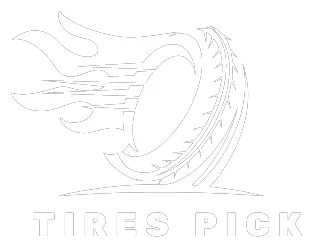Purchasing tires isn’t just about getting a black, rubbery circle to fit onto your car’s rims. It’s an intricate science that affects your safety, vehicle performance, and driving comfort.
But let’s be real, tire codes like 121t, 121s, 121q, 121h, 121r, 121v, 121w look more like an encrypted message from a spy movie than a useful piece of information. But fear not! I’m here, your humble tire decrypter, to break down these codes for you.
What Does 121t, 121s, 121q, 121h, 121r, 121v, 121w Mean on a Tire
These codes are called “service descriptions.” Each service description consists of a Load Index (a number) and a Speed Symbol (a letter). The number represents the tire’s load carrying capacity, and the letter signifies the maximum speed the tire can sustain under its recommended load capacity. Here’s a little table to visualize it:
| Service Description | Load Index (121) | Speed Symbol |
| 121T | Up to 3195 lbs | 118 mph |
| 121S | Up to 3195 lbs | 112 mph |
| 121Q | Up to 3195 lbs | 99 mph |
| 121H | Up to 3195 lbs | 130 mph |
| 121R | Up to 3195 lbs | 106 mph |
| 121V | Up to 3195 lbs | 149 mph |
| 121W | Up to 3195 lbs | 168 mph |
Now, let’s dig a little deeper into these mysterious letters.
What Does 121T Mean on a Tire?
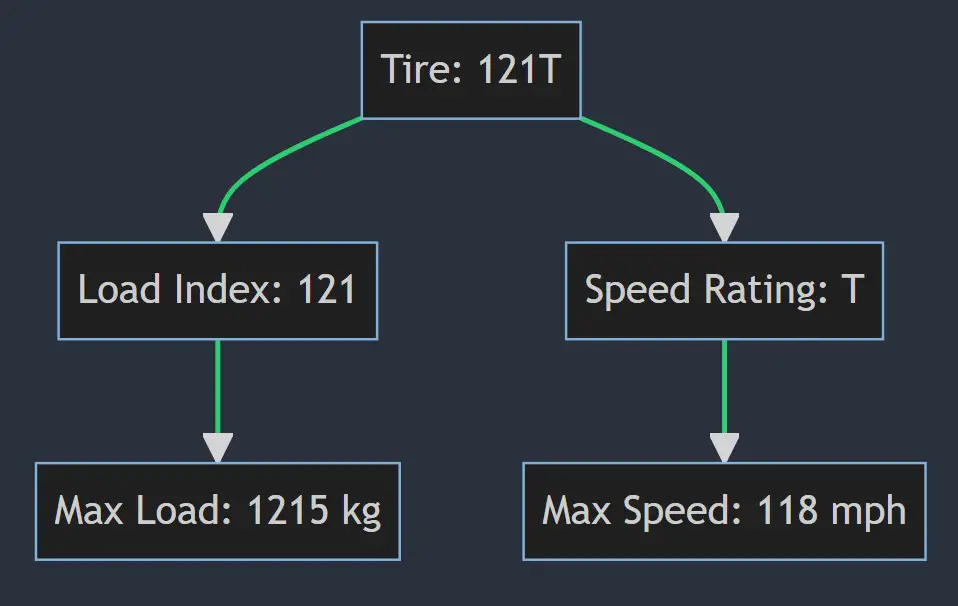
121T, as all the others, is a service description. The “121” part is the Load Index. Load Index isn’t something like the “load index” of your laundry basket when your teenager dumps a month’s worth of dirty clothes into it. It’s a standardized measure indicating how much weight the tire can safely support. For tires with a 121 load index, this is a cool 3195 lbs (1451 kg). That’s the weight of an average rhino, a small sailboat, or 191,071 chicken nuggets!
The “T” stands for the Speed Symbol, representing the maximum speed at which the tire can carry a load corresponding to its Load Index. “T” corresponds to a maximum speed of 118 mph (190 km/h). That’s faster than the top speed of a cheetah, the world’s fastest land animal. But unlike the cheetah, your 121T tire can keep this pace for hours on end (as long as you can keep your foot on the gas pedal, of course!).
When to Choose 121T?
- If you’re a highway speedster: With its 118 mph speed limit, 121T is a great choice for those long drives on open highways.
- For heavier vehicles: If you’re driving a larger vehicle or planning to transport heavy loads, the 121T’s robust load index can support that extra weight.
- Off-road warriors: The sturdy construction necessary to meet the 121T rating often coincides with a good balance of durability and performance. Ideal for off-roaders who love to explore the path less traveled!
What Does 121S Mean on a Tire?
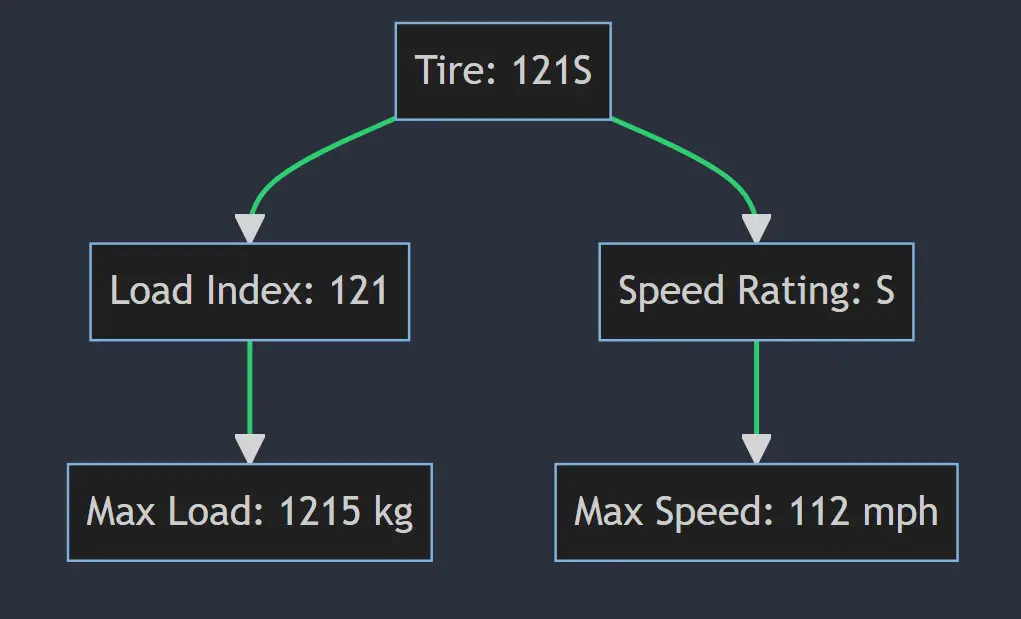
The term “121S” may seem like a cryptic message left by an absent-minded tire technician, but fear not, it’s a crucial part of understanding your tire’s performance and compatibility.
The “121” part of 121S refers to the tire’s load index, indicating that the tire can support up to 3195 lbs. It’s like the Hulk of tires, handling large loads without breaking a sweat! The “S” in the 121S stands for the Speed Symbol and corresponds to a maximum speed of 112 mph (180 km/h). It’s not quite up to the pace of a cheetah but definitely outpaces the swift-footed pronghorn antelope, the second fastest land animal.
When to Choose 121S?
- Everyday driving: The 121S is perfect for regular, daily driving conditions with its combination of high-load capacity and a respectable maximum speed.
- Mixed driving conditions: If you often navigate between city streets, highways, and the occasional light off-road trails, 121S tires offer a good balance.
- Medium-sized SUVs and light trucks: Vehicles of these types often benefit from the load and speed characteristics of 121S tires.
As they say, knowledge is power, and when it comes to tires, it’s all about understanding the language of the road – or should we say, the language of the rubber!
What Does 121Q Mean on a Tire?
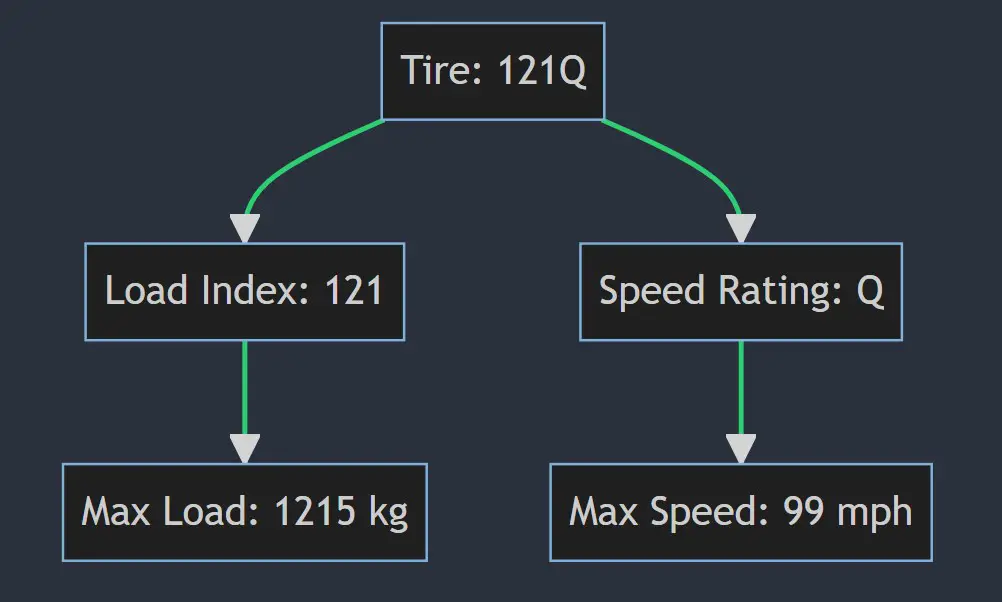
Moving on to 121Q, where “121” remains a load index of 3195 lbs. A 121Q tire could bear the weight of nearly 20,000 footballs! On the other hand, “Q” as the Speed Symbol corresponds to a maximum speed of 99 mph (160 km/h). That’s faster than the official speed record of a horse – not bad for a piece of rubber, eh?
When to Choose 121Q?
- Winter conditions: Q-rated tires are often winter tires, designed for improved traction in snowy or icy conditions.
- Heavier loads: If your vehicle is often loaded up with equipment or other heavy items, 121Q’s solid load index makes it a reliable option.
- Safety-conscious drivers: The slightly lower speed rating encourages safer, slower driving.
Choosing 121Q is like hiring a Saint Bernard to pull your sled – strong, dependable, and perfect for the snow!
What Does 121H Mean on a Tire?
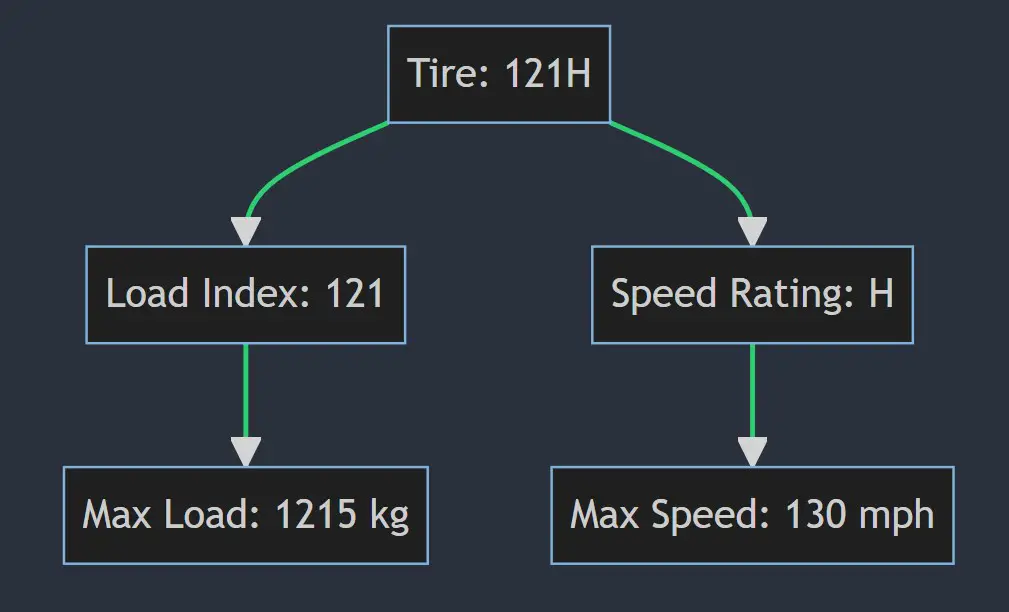
In the tire code 121H, “121” signifies the tire’s load index, indicating it can support up to 3195 lbs, like all its 121 siblings. However, “H” is the Speed Symbol here, standing for a maximum speed of 130 mph (210 km/h). If your 121H tire was an animal, it would be a quarter horse, famed for its incredible acceleration.
When to Choose 121H?
- Performance cars: If you drive a sports car or any other vehicle designed for higher speeds, 121H tires can help you make the most of it.
- High-speed highways: For those frequent highway drives where the speed limits are generous.
- Sporty drivers: If you like a spirited drive now and then, these tires will let you explore your car’s performance safely.
By choosing a 121H tire, you’re embracing your inner race car driver. Remember to drive responsibly and enjoy the open road!
What Does 121R Mean on a Tire?
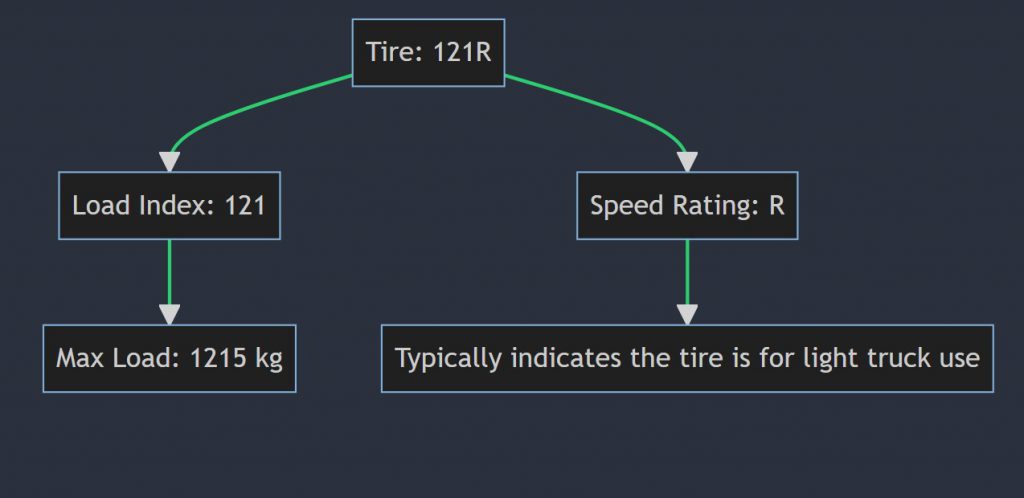
The tire code “121R” looks like a secret code straight out of a James Bond movie, but it’s actually quite simple. The “121” represents the Load Index, with a carrying capacity of 3195 lbs. The “R” as the Speed Symbol refers to a maximum speed of 106 mph (170 km/h). You may not win a drag race against a cheetah with this tire, but you’d definitely outpace a greyhound!
When to Choose 121R?
- Off-road enthusiasts: 121R tires are often associated with all-terrain and off-road use, offering great grip and stability on non-asphalt surfaces.
- Vans and light trucks: These vehicles benefit from the generous load capacity and decent speed limits of 121R tires.
- Mixed terrain drivers: If you drive both city streets and rough roads, these tires offer the versatility you need.
Choosing 121R tires is like adopting a mountain goat. They’re rugged, adaptable, and perfectly comfortable on the path less traveled!
What Does 121V Mean on a Tire?
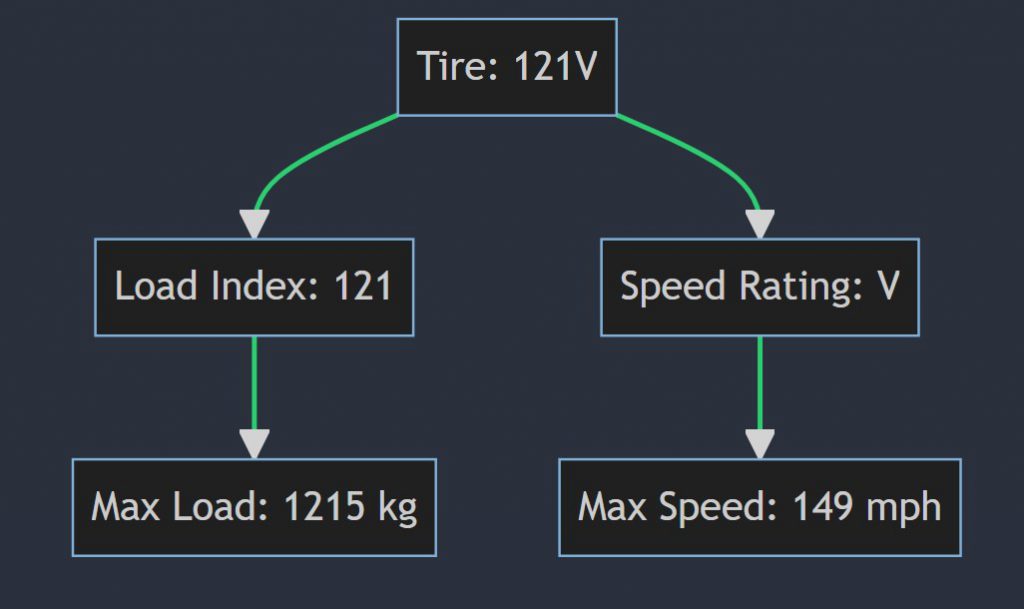
The code “121V” on a tire tells us that the tire can support a load up to 3195 lbs, represented by “121”, and can achieve a maximum speed of 149 mph (240 km/h), denoted by “V”. To put it in perspective, a 121V tire is like a falcon—fast and capable of carrying heavy loads compared to its size.
When to Choose 121V?
- Performance vehicles: Sports cars and high-performance sedans will greatly benefit from the high-speed capabilities of a 121V tire.
- High-speed commuting: If you frequently travel on highways with high-speed limits, these tires are well suited.
- Speed enthusiasts: If you like pushing your vehicle’s speedometer now and then, 121V tires will ensure your car can safely handle those speeds.
Choosing 121V tires is like strapping a pair of wings to your car—ready to fly (metaphorically, of course) on the highways!
What Does 121W Mean on a Tire?
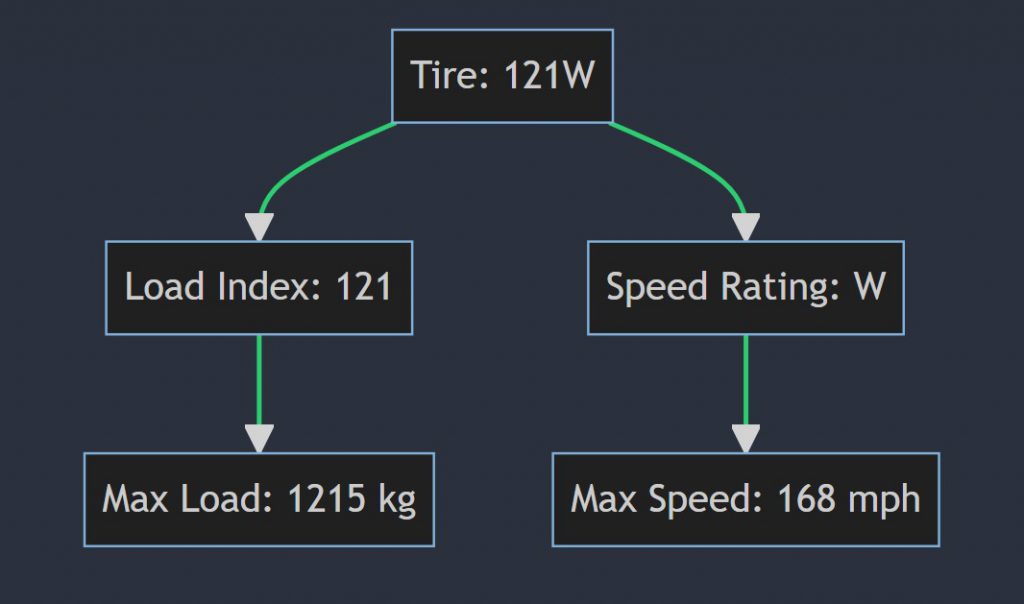
In the case of a 121W tire, the “121” is the Load Index, meaning it can support a hefty 3195 lbs. The “W” stands for the Speed Symbol and corresponds to a maximum speed of 168 mph (270 km/h). If 121W was an animal, it would be a peregrine falcon, the fastest creature on Earth.
When to Choose 121W?
- High-performance cars: If you’re lucky enough to drive a sports car or any high-performance vehicle, 121W tires are designed to let you fully exploit its potential.
- Track day enthusiasts: If you enjoy track days, these tires will safely handle those high-speed corners.
- Adrenaline junkies: For those who like to live in the fast lane, quite literally.
Remember, by choosing a 121W tire, you’re signing up for the speed of a falcon. Always respect local traffic laws and drive responsibly!
FAQs
121Q vs 125Q
Both 121Q and 125Q tire codes have “Q” as their Speed Symbol, which denotes a maximum speed of 99 mph. The difference lies in the Load Index. A 121Q tire can carry up to 3195 lbs, while a 125Q tire can support a heavier load of up to 3638 lbs. Essentially, 125Q tires are better suited for heavier vehicles or situations where more weight is being carried.
121Q vs 121R
121Q and 121R tires share the same Load Index of 121, meaning they can both carry up to 3195 lbs. However, their Speed Symbols differ. “Q” represents a max speed of 99 mph, and “R” indicates a max speed of 106 mph. So, if you expect to drive at slightly higher speeds, a 121R would be the better choice.
121Q vs 124Q
These two tire codes both have a Speed Symbol of “Q,” signifying a maximum speed of 99 mph. The Load Index differs, with 121Q tires capable of supporting up to 3195 lbs, while 124Q tires can support up to 3527 lbs. Therefore, a 124Q tire would be better for heavier vehicles or for carrying heavier loads.
Recap and Summary
In a world filled with confusing tire codes, we’ve unlocked the mystery behind 121t, 121s, 121q, 121h, 121r, 121v, and 121w. All these tires can carry loads of up to 3195 lbs, the equivalent of an average hippo or an uncomfortably large heap of spaghetti! The differences lie in their speed capabilities, ranging from a decent 99 mph (perfect for navigating a snowstorm in the safety of your car) to a whopping 168 mph (should you ever want to race a peregrine falcon).
Choosing the right tire ultimately depends on your vehicle type, driving conditions, and personal preference. While 121T might be perfect for the highway cruisers and off-road warriors, 121W might be the choice for those speed demons with their high-performance vehicles. And let’s not forget our 121Q winter warriors, navigating through the snow like a trusty Saint Bernard.
So, next time you’re confronted with an indecipherable tire code, don’t fret! You’ve got the knowledge, the power, and the wisdom of the tire gods on your side. Safe travels!
Alternative Tire Size Codes of Similar Specifications

AR Jeet has been a tire mechanic for over 2years. He has worked on all types of vehicles, from cars and trucks to RVs and ATVs and motorcycles. He has seen it all when it comes to tires, and he knows how to fix them.
AR Jeet is a tire expert, and he is passionate about his work. He loves to help people keep their vehicles running smoothly, and he is always happy to answer any questions that people have about their tires.
If you need help with your tires, or if you just want to learn more about them, then AR Jeet is the man to talk to. He will be happy to help you out, and he will make sure that you get the best possible solution.
He has a blog [Tirespick.com] where he writes about all things tire-related, and he is always happy to help people with their tire needs. Know more about AR Jeet.
